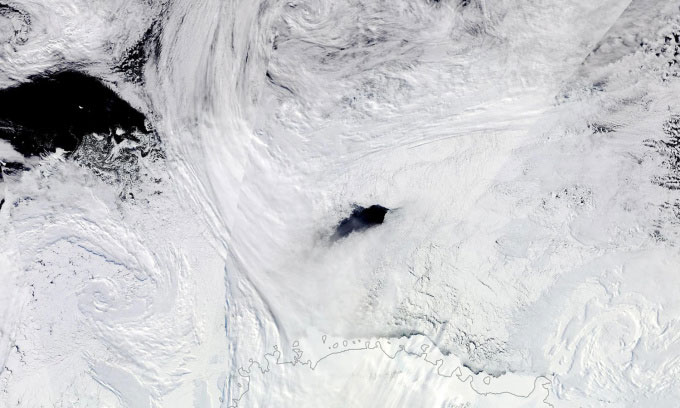Decoding the 80,000km2 broadband gap in Antarctica
The Maud Rise ice gap formed in open ocean and away from coastal winds, puzzling scientists for years .
Researchers discovered the Maud Rise ice gap - an open water area surrounded by sea ice - in 1974 and 1976 in the Weddell Sea, Antarctica. Since then, this hole has reappeared many times in different sizes in the same location, but sometimes disappears for years at a time. This confuses the scientific community and it is not clear what the exact conditions are for the hole to form.

Maud Rise ice hole seen from above. (Photo: Earth Observatory NASA)
In 2016 and 2017, the 80,000km 2 hole opened for several weeks during both winters, giving scientists the opportunity to learn more and finally decode this mystery, Live Science reported on May 3. believe. The new study, published in the journal Science Advances , was conducted by postdoctoral researcher Aditya Narayanan at the University of Southampton and his colleagues.
In Antarctica, when moving from summer to winter, sea ice expands from a minimum area of about 3 million km 2 to 18 million km 2 , covering 4% of the Earth's surface. Most sea ice grows during the "polar night" - a phenomenon that lasts weeks - on the floating ice shelves surrounding the continent. Ice holes, called polynya , form when strong continental winds push ice blocks apart. This cold wind also further freezes the seawater inside the holes.
But in open waters and away from coastal winds, where the Maud Rise gap occurs, ice gaps are less likely to form. This problem, combined with the decline in ice size in the Southern Ocean, has scientists wondering about the factors that create the Maud Rise gap.
To solve the mystery, Narayanan and his colleagues studied data from satellites, automated buoys, tagged marine mammals, and old observations from other researchers. They found that in 2016 and 2017, the Weddell Sea's circular current, the Weddell Gyre, was stronger than in other years, making it easier for underwater currents to bring salt and heat closer to the surface.
The Maud Rise ice hole is located near the Maud Rise submarine mountain. In 2016 and 2017, due to stronger ocean currents, salt suspended around the mountain while winds blew on the surface, creating a spiral effect that pulled salt water around the mountain to the sea surface. Salt lowers the freezing point of surface water, allowing the Maud Rise ice gap to form.
The new discovery is important in understanding Antarctica and the continent's broader impacts on the global ocean, the team said. Climate change makes winds from the continent stronger, which in turn could create more ice holes in the future. Meanwhile, 40% of global ocean water originates from the Antarctic coast, making this place extremely important in regulating the climate of regions on Earth.
- Nearly twice the broadband of Hanoi is about to drift away from Antarctica
- Broadband Internet - Vietnam: An attractive market
- Mysterious decoding of strange ice holes constantly appearing in Antarctica for decades
- Climate change causes snow in Antarctica to turn green
- From 1-6, broadband will be faster, cheaper!
- Beams: interesting Antarctica
- 90 million years ago, West Antarctica was a vast rain forest
- Antarctica - 'fire hell' between the earth in the coldest place in the world
- We lost the Botnet battle?
- WiBro is in danger
- Antarctica is warming up
- Decode cheap DNA
 Is the magnetic North Pole shift dangerous to humanity?
Is the magnetic North Pole shift dangerous to humanity? Washington legalizes the recycling of human bodies into fertilizer
Washington legalizes the recycling of human bodies into fertilizer Lightning stone - the mysterious guest
Lightning stone - the mysterious guest Stunned by the mysterious sunset, strange appearance
Stunned by the mysterious sunset, strange appearance